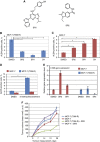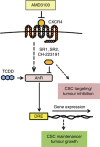CXCR4 activation maintains a stem cell population in tamoxifen-resistant breast cancer cells through AhR signalling
- PMID: 22644306
- PMCID: PMC3389396
- DOI: 10.1038/bjc.2012.105
CXCR4 activation maintains a stem cell population in tamoxifen-resistant breast cancer cells through AhR signalling
Abstract
Background: Tamoxifen is commonly used for breast cancer therapy. However, tamoxifen resistance is an important clinical problem. Continuous treatment with conventional therapy may contribute to cancer progression in recurring cancers through the accumulation of drug-resistant cancer progenitors.
Methods: To investigate signalling mechanisms important for the maintenance and viability of drug-resistant cancer progenitors, we used microarray analysis, PCR array for genes involved in cancer drug resistance and metabolism, flow cytometry, soft agar colony formation assay, in vivo tumourigenicity assay and immunohistochemical analysis using tamoxifen-sensitive and tamoxifen-resistant breast cancer MCF7 cells.
Results: Downregulation of CXCR4 signalling by small molecule antagonist AMD3100 specifically inhibits growth of progenitor cell population in MCF7(TAM-R) cells both in vitro and in vivo. Microarray analysis revealed aryl hydrocarbon receptor (AhR) signalling as one of the top networks that is differentially regulated in MCF7(TAM-R) and MCF7 xenograft tumours treated with AMD3100. Further, small molecule antagonists of AhR signalling specifically inhibit the progenitor population in MCF7(TAM-R) cells and growth of MCF7(TAM-R) xenografts in vivo.
Conclusion: The chemokine receptor CXCR4 maintains a cancer progenitor population in tamoxifen-resistant MCF7 cells through AhR signalling and could be a putative target for the treatment of tamoxifen-resistant breast cancers.
Figures





Similar articles
-
Dicer-mediated upregulation of BCRP confers tamoxifen resistance in human breast cancer cells.Clin Cancer Res. 2011 Oct 15;17(20):6510-21. doi: 10.1158/1078-0432.CCR-11-1403. Epub 2011 Aug 30. Clin Cancer Res. 2011. PMID: 21878538 Free PMC article.
-
Tamoxifen-resistant breast cancer cells possess cancer stem-like cell properties.Chin Med J (Engl). 2013 Aug;126(16):3030-4. Chin Med J (Engl). 2013. PMID: 23981606
-
Tumor-associated macrophages secrete CC-chemokine ligand 2 and induce tamoxifen resistance by activating PI3K/Akt/mTOR in breast cancer.Cancer Sci. 2020 Jan;111(1):47-58. doi: 10.1111/cas.14230. Epub 2019 Dec 19. Cancer Sci. 2020. PMID: 31710162 Free PMC article.
-
Phosphoproteomic Analysis Identifies Focal Adhesion Kinase 2 (FAK2) as a Potential Therapeutic Target for Tamoxifen Resistance in Breast Cancer.Mol Cell Proteomics. 2015 Nov;14(11):2887-900. doi: 10.1074/mcp.M115.050484. Epub 2015 Sep 1. Mol Cell Proteomics. 2015. PMID: 26330541 Free PMC article.
-
STAT3 Signaling Axis and Tamoxifen in Breast Cancer: A Promising Target for Treatment Resistance.Anticancer Agents Med Chem. 2023;23(16):1819-1828. doi: 10.2174/1871520623666230713101119. Anticancer Agents Med Chem. 2023. PMID: 37448364 Review.
Cited by
-
Divergent roles of CXCR3 isoforms in promoting cancer stem-like cell survival and metastasis.Breast Cancer Res Treat. 2015 Jan;149(2):403-15. doi: 10.1007/s10549-014-3229-7. Epub 2014 Dec 24. Breast Cancer Res Treat. 2015. PMID: 25537642 Free PMC article.
-
Transcriptional profiling reveals elevated Sox2 in DNA polymerase ß null mouse embryonic fibroblasts.Am J Cancer Res. 2012;2(6):699-713. doi: 10.1158/1538-7445.am2012-699. Epub 2012 Nov 20. Am J Cancer Res. 2012. PMID: 23226616 Free PMC article.
-
Bioinformatics Studies Provide Insight into Possible Target and Mechanisms of Action of Nobiletin against Cancer Stem Cells.Asian Pac J Cancer Prev. 2020 Mar 1;21(3):611-620. doi: 10.31557/APJCP.2020.21.3.611. Asian Pac J Cancer Prev. 2020. PMID: 32212785 Free PMC article.
-
In vivo effect of statins on the expression of the HIV co-receptors CCR5 and CXCR4.AIDS Res Ther. 2013 May 1;10:10. doi: 10.1186/1742-6405-10-10. eCollection 2013. AIDS Res Ther. 2013. PMID: 23634877 Free PMC article.
-
Environmental exposure and the role of AhR in the tumor microenvironment of breast cancer.Front Pharmacol. 2022 Dec 15;13:1095289. doi: 10.3389/fphar.2022.1095289. eCollection 2022. Front Pharmacol. 2022. PMID: 36588678 Free PMC article. Review.
References
-
- Bouchez LC, Boitano AE, de Lichtervelde L, Romeo R, Cooke MP, Schultz PG (2011) Small-molecule regulators of human stem cell self-renewal. ChemBioChem 12(6): 854–857 - PubMed
-
- Bunting KD (2002) ABC transporters as phenotypic markers and functional regulators of stem cells. Stem Cells 20(1): 11–20 - PubMed
-
- Burger JA, Burger M, Kipps TJ (1999) Chronic lymphocytic leukemia B cells express functional CXCR4 chemokine receptors that mediate spontaneous migration beneath bone marrow stromal cells. Blood 94(11): 3658–3667 - PubMed
-
- Clark AS, West K, Streicher S, Dennis PA (2002) Constitutive and inducible Akt activity promotes resistance to chemotherapy, trastuzumab, or tamoxifen in breast cancer cells. Mol Cancer Ther 1(9): 707–717 - PubMed
Publication types
MeSH terms
Substances
LinkOut - more resources
Full Text Sources
Molecular Biology Databases

